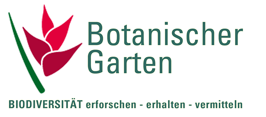About the Botanical Garden of Osnabrück
Location and Area
The Botanical Garden of the University of Osnabrück comprises a core area of 8.4 ha. The area is subdivided between two quarries connected by a tunnel. One quarry of 5.6 ha houses the outdoor plant collections, glasshouses, and outdoor testing areas as well as the administrative buildings. The second quarry of 2.8 ha, which was recently added to the Botanical Garden, is kept in its natural condition. The Botanical Garden also maintains the outdoor area of the university’s Department of Biology. This area of 3.0 ha is permanently open to the public and home to different woody plants.Geology
The two quarries of the Botanical Garden are an enclosed area which can be visited during the opening hours (Entry is free; dogs, except guide dogs are not permitted in the Garden). The quarries’ rock layers contain shellbearing limestone from the Lower Muschelkalk period. Limestone was quarried here to provide building material for several historic buildings in the Old Town of Osnabrück, for example the Heger Tor. The remains of the old quarry forming the main area of the Botanical Garden show an impressive relief with steep rock faces and a plateau in its centre. This plateau was turned into an Alpinum and now houses the Alpine plant collection. In the rock faces you can easily distinguish different sedimentary rock strata in North-East-inclination. These limestone layers were formed of the organic deposits at the bottom of a prehistoric subtropical ocean in the Lower Muschelkalk period of the Trias. Therefore they are approximately 230 Million years old.
Display boards placed at interesting points throughout the Botanical Garden provide detailed information about its geological history. A German brochure about the geology of the Garden was published in Schriftenreihe des Freundeskreises Botanischer Garten der Universität Osnabrück e. V. You can acquire this brochure, named “Nr. 6 – Geologie”, in the Botanical Garden’s secretarial office.
Outdoor Display Gardens
Due to the Botanical Garden’s scientific concept the Outdoor Display Gardens have several foci: the temperate zones of Northern America and Asia, European Mountain areas, South-German Swabian Jura, European ravine forest and the Mediterranean. The Botanical Garden shows specific plant formations typical to these geographical units. These plant formations are complexes of vegetation types, which mirror the life forms of the respective areas, their ecological conditions and also historical factors influencing plant life. However, due to the limited space it is not possible to show all facets of a certain plant formation.In addition to the geographic units there are several thematic collections, including a collection of medical plants, a collection of plants from the heath family (Ericaceae), a collection of members of the garlic family (Alliaceae) and a Tertiary Garden. Further information can be found in the German brochure “Gartenführer”.
Conservation Area (Natural Quarry)
In 2011 a second abandoned quarry of 2.8 ha was added to the Botanical Garden. This quarry was, as far as possible, restored to its natural condition and is now being turned into a conservation area. With its calcareous grassland extremely low in nutrients it houses a rare and threatened pioneer plant association typical to recently abandoned limestone quarries. Furthermore two old quarry tunnels were transformed into hibernation quarters for bats which are already accepted by five different species.The second quarry can be reached from the Outdoor Display Gardens by means of a tunnel.
Glasshouses
From the moment of the Garden’s foundation on there was the dream of building glasshouses rising above the quarry’s steep faces and thus offering the unique possibility for visitors and students to step into the treetops and get to know the rich and diverse flora of this hidden habitat.In 1996 this idea was finally put into reality. Two years later the first glasshouse in the Botanical Garden was opened to the public. With its impressive dimensions of 21 meters in height and a floor space of 600m2 the Lowland Rainforest House is now home to more than 800 species of tropical plants from Central and South America. It is the first of five buildings which are planned to form the Botanical Garden’s future “Tropicarium”.
The second building, the “Bohnenkamp-Haus”, was opened to the public in 2011. It forms a
Foyer to the Lowland Rainforest House and furthermore offers several course rooms, an auditorium and space to house the Botanical Garden’s carpological collection of seed and fruit. In addition to the Lower Rainforest House and the Bohnenkamp-Haus the Garden plans a Cloud Forest House, a Dry Tropics House and a Halophytes’ House.
Further information on the “Tropicarium” you can find in the German brochure “Führer durch das Regenwaldhaus”.
Science and Education
As an institution of Osnabrück University’s Faculty of Biology and Chemistry the Botanical Garden is dedicated to science and education. It offers scientific plant collections, indoor and outdoor testing areas and plants to be used in University courses. There is also a scientific library open to students and botanists.Furthermore the garden of course strives to offer an insight into the fascinating world of plants to everybody who is interested.

